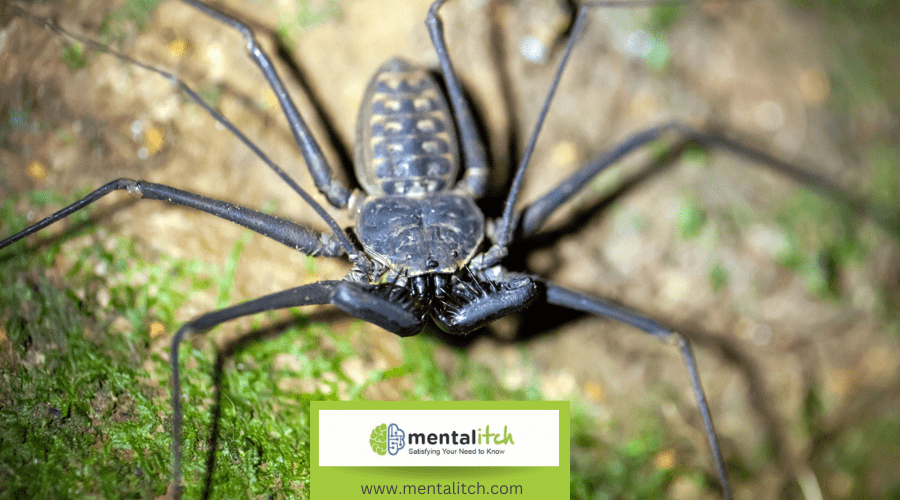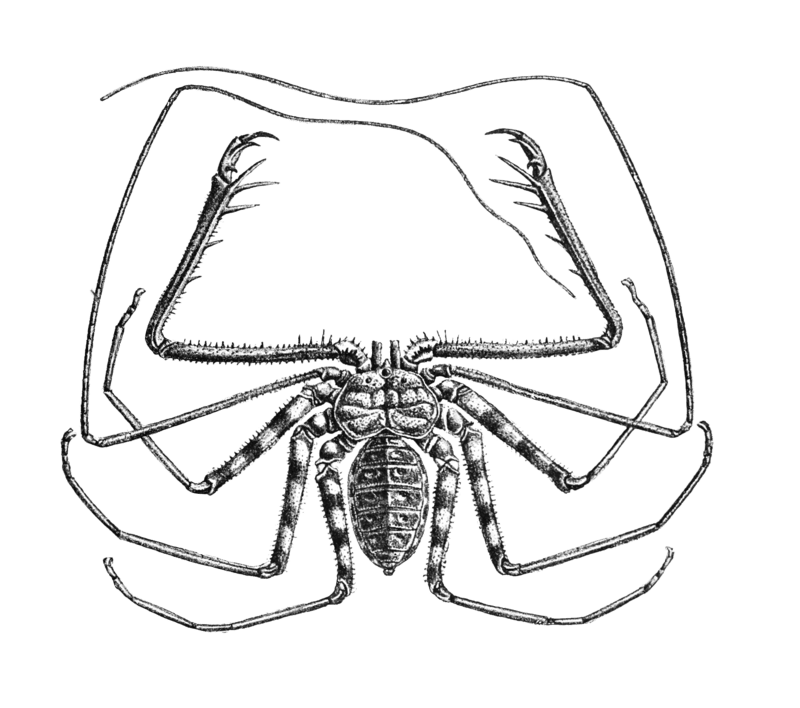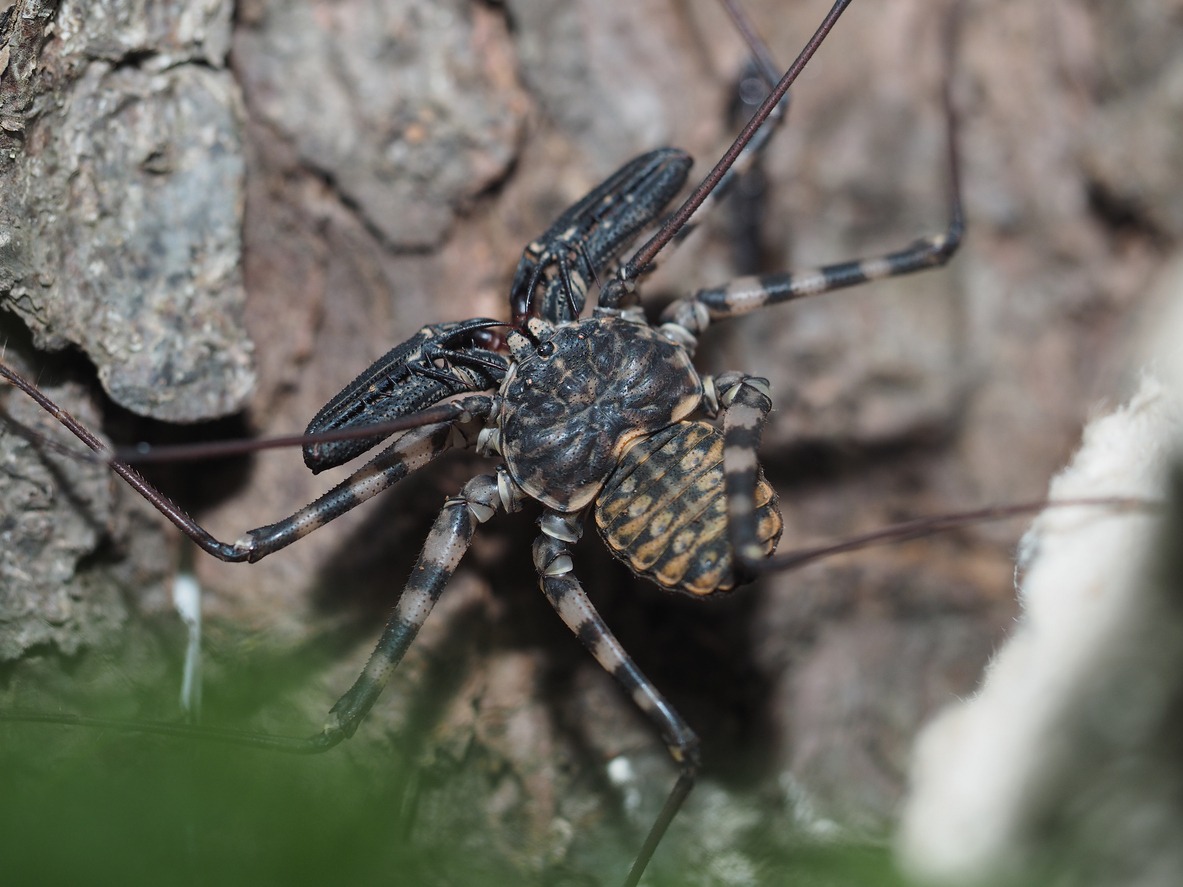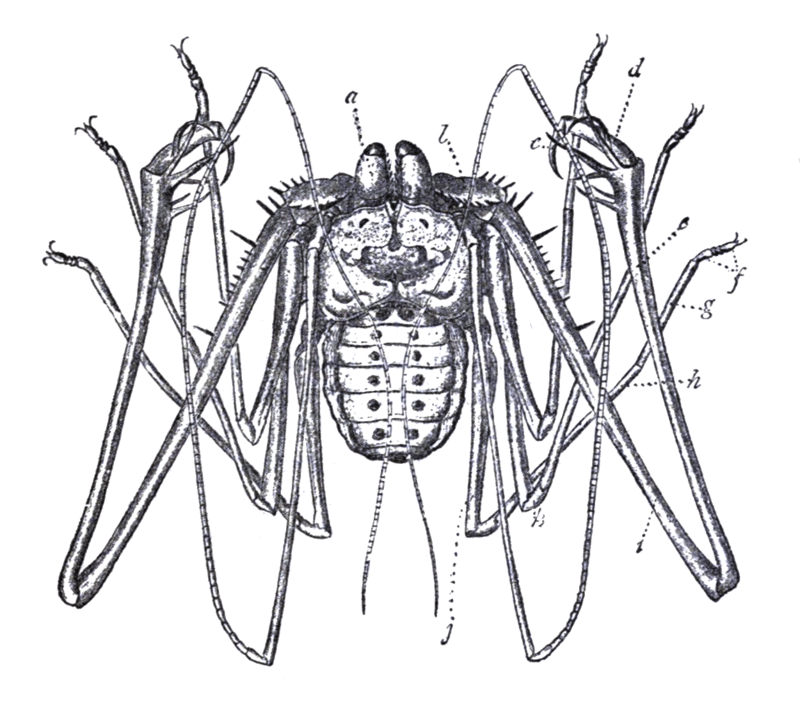While you might think all arachnids share the same menacing traits, the whip spider sets itself apart in several fascinating ways. You’ll find that its unique sensory limbs, not found in common spiders or scorpions, allow for an intriguing approach to traversing their environment. Unlike its relatives, the whip spider doesn’t rely on venom to subdue prey, but rather on its adept physical prowess and strategic hunting techniques. Their preference for both damp and arid shelters showcases an impressive adaptability.
Now, consider the whip spider’s complex social behaviors and mating rituals; these aspects not only differentiate it from other arachnids but also hint at a rich area for exploration, especially regarding how these creatures communicate and thrive in their ecosystems.
Unique Sensory Limbs
Whip spiders boast elongated antenniform forelegs equipped with chemo- and mechanosensory sensilla, important for prey detection and exploration. These unique sensory limbs aren’t just for show; they’re essential for your survival in the wild. Imagine exploring the dark, relying on these limbs to sense the slightest vibrations or chemical signals in the air. That’s your reality as a whip spider.
Your elongated forelegs, acting as nature’s own sophisticated sensors, allow you to execute precise hunting techniques. You can detect prey from a distance, all thanks to the tactile feedback these sensory sensilla provide. It’s not all about offense, though. These limbs play a defensive role as well, helping you sense predators and escape threats in your environment.
The flagella on your head add another layer to your sensory arsenal. Highly sensitive to touch and movement, they aid in prey detection and predator avoidance, ensuring you’re always one step ahead. It’s this combination of unique sensory limbs, from your elongated antenniform forelegs to the flagella, that underpins your hunting techniques, defensive strategies, and overall survival. In the world of arachnids, your sensory capabilities truly set you apart.
Non-Venomous Nature
Unlike many of their arachnid cousins, you, as a whip spider, don’t possess venom glands or venomous fangs to subdue your prey. This non-venomous nature sets you apart in the arachnid world, where many rely on venom for prey capture and defense. Instead, your survival hinges on a unique blend of speed, agility, and specialized sensory organs. These adaptations enable you to excel in hunting without the need for venomous attacks.
Your primary defense mechanism isn’t venom but your ability to dart away quickly, using your long legs not just for mobility but also for protection. This reliance on physical prowess over venomous bites is a confirmation of your evolutionary path. You’ve developed unique hunting techniques that leverage your physical attributes, ensuring you remain a formidable predator despite your non-venomous nature.
The absence of venom glands in whip spiders highlights a significant divergence from other venomous arachnids like scorpions and some spiders. This distinction underscores the diverse survival strategies within the arachnid family, with you, the whip spider, showcasing how speed, agility, and specialized sensory organs can compensate for the lack of venom in prey capture and defense.
Habitat Diversity
Your adaptability extends beyond hunting techniques to the variety of environments you call home, reflecting the remarkable habitat diversity of whip spiders. As a nocturnal creature, you’ve mastered the art of hiding during the day in the most inconspicuous places. Your resilience is evident in how you’ve adapted to thrive across a spectrum of conditions, from the dense foliage of rainforests to the arid landscapes of deserts and even within the bustling confines of urban areas. Here’s a glimpse into the diverse habitats you inhabit:
- Tropical and subtropical regions: where the warmth and humidity suit your needs perfectly.
- Temperate zones: fewer in number, but certain species like Charinus ionnaticus find solace in the mild climates of Greek islands such as Kos and Rhodos.
- Urban areas: demonstrating your adaptability by thriving in human-dominated landscapes, taking refuge in cracks and crevices of buildings.
- Rainforests and deserts: showcasing your ability to occupy both ends of the moisture spectrum, from the damp underbrush of rainforests to the dry, open spaces of deserts.
Your ability to occupy such diverse habitats speaks volumes about your adaptability and resilience as a species.
Social Behaviors
Despite their impressive adaptability in various habitats, you tend to lead a solitary life, devoid of social interactions or group dynamics. Your existence highlights a unique aspect of the arachnid world where social behaviors such as colony formation or cooperative hunting are virtually nonexistent. Unlike many of your arthropod cousins, you don’t engage in sophisticated communication with conspecifics, except for what’s necessary during mating rituals, which we’ll steer clear of discussing here.
Your survival strategy doesn’t rely on the strength of numbers or the complexity of social networks. Instead, you bank on your individual hunting skills and remarkable agility. These traits allow you to navigate your environment and secure prey with efficiency, underscoring your preference for a solitary lifestyle. Limited research on your kind has shown that you prioritize individual survival and reproduction above all else. This focus on the self over the collective is a sign of your resilience and adaptability as a species.
Mating Rituals
In the world of whip spiders, courtship is a complex dance, with males showcasing their dominance and fitness through specific rituals to attract females. These mating rituals are not just mere attractions; they’re a critical assessment phase where females evaluate the males’ suitability as a mate through elaborate behaviors and intricate movements. This selection process guarantees that only the most fit males get to pass on their genes.
To paint a picture of these unique courtship dances, consider the following:
- Leg Tapping: A rhythmic movement that signals the male’s presence and readiness to mate.
- Antennal Movements: Utilized by males to display dominance and attract females through subtle, yet specific, gestures.
- Body Vibrations: Serve as communication signals, conveying the male’s vitality and eagerness to mate.
- Dominance Displays: These are essential for the male to prove his worth and fitness as a potential mate, involving a series of postures and movements.
Following these elaborate mating rituals, successful courtship leads to mating, after which the female whip spider engages in egg laying, continuing the cycle of life. Through these rituals, whip spiders exhibit a fascinating aspect of their behavior, emphasizing the importance of female assessment in the selection of a mating partner.
Predator Avoidance Techniques
Following the intimate dance of mating rituals, let’s explore how whip spiders manage to evade their predators with remarkable agility and cunning. Thanks to their long, thin legs covered with spines, these arachnids perform fast movements that confuse and outrun their pursuers. But that’s just the beginning of their defensive repertoire.
| Technique | Description |
|---|---|
| Dancing | A unique behavior where whip spiders move in a way to intimidate predators. |
| Sensitive Flagella | Helps in detecting threats, allowing for a quick response. |
| Elongated Antenniform Forelegs | Used to sense vibrations and movements, aiding in predator detection. |
| Specialized Hunting Techniques | Evolved to include quick reflexes, essential for escaping predators. |
| Spines on Legs | Aid in both defense and mobility, making them harder targets. |
Your whip spider utilizes these techniques, not just for hunting, but also to guarantee its survival against predators. Their ability to ‘dance’ away from danger, coupled with the sensitive flagella and elongated antenniform forelegs, makes them experts in predator detection. With specialized hunting techniques and quick reflexes, whip spiders stand out in the arachnid world not only for how they catch their prey, but how they avoid becoming it.
Conservation Status
While whip spiders aren’t currently on the IUCN Red List, this absence reflects a gap in conservation assessment rather than an assurance of their safety. Their unique ecological roles and genetic diversity are under threat, yet we lack comprehensive data on their conservation status. This is due to limited information on population trends, distribution, and the specific threats they face.
To paint a clearer picture, consider the following key points:
- Limited data on population trends and distribution hinder effective conservation efforts for whip spiders.
- Habitat loss, deforestation, and climate change pose significant threats to their survival.
- The lack of formal conservation status assessment underscores the urgent need for research and field studies.
- Protecting whip spiders is crucial to preserving their unique ecological roles and genetic diversity.
You’re stepping into a world where understanding and action are critical. Field studies and further research are essential to shed light on the obscure corners of whip spider life. This knowledge is the key to devising effective conservation measures that ensure these fascinating creatures aren’t just a footnote in the annals of biodiversity.
Conclusion
In the arachnid world, whip spiders truly stand out. Their unique sensory limbs and non-venomous nature set them apart. They thrive in diverse habitats, from damp environments to dry caves, showcasing their adaptability. Whip spiders are also known for their social behaviors, intricate mating rituals, and clever predator avoidance techniques. Despite their intimidating appearance, they play an essential role in their ecosystems. It’s important we grasp their conservation status to make certain these fascinating creatures continue to thrive.



